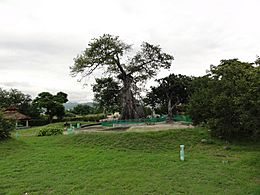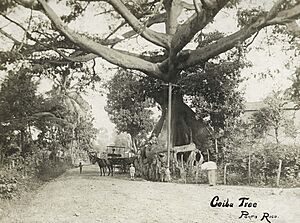Parque de la Ceiba facts for kids
Quick facts for kids Parque de la Ceiba |
|
|---|---|

The Ceiba tree at Parque de la Ceiba in Barrio San Anton in Ponce, PR, as it appeared in November 2010
|
|
| Type | Passive park |
| Location | PR-133/Calle Comercio, Cuatro Calles sector, Barrio San Antón, in Ponce, Puerto Rico |
| Area | approx 0.6 cuerdas |
| Created | 1984 |
| Operated by | Autonomous Municipality of Ponce |
| Status | Open Daily, 8am to 4:30pm |
Parque de la Ceiba (which means Ceiba Tree Park in English) is a special park in Ponce, Puerto Rico. It's located in the San Antón area. The most important part of the park is a very old and famous Ceiba tree. This tree is connected to how the city of Ponce first started.
The amazing 500-year-old Ceiba tree stands right next to the historic part of Ponce. The park itself opened in 1984. A sign at the park tells us the tree's scientific name is Ceiba pentandra.
Contents
Where is Ceiba Tree Park?
The park is on Comercio street, right next to the Rio Portugues river. This area is called Cuatro Calles. Today, it's a mix of homes and businesses along a road called PR-133. The city government of Ponce takes care of the park. The famous tree is about half a mile east of a main square called Plaza Las Delicias.
A Look Back: History of the Park
The park is built on a spot where people believe Europeans first settled in the Ponce area. Long ago, before the Spanish arrived, Taíno Native Americans lived here. Broken pieces of their pottery, shells, and stones have been found around the Ceiba tree. This shows that the Taíno people were here a very long time ago.
Some people say this Ceiba tree was already very big when Christopher Columbus first came to the New World. A book even suggests the tree was there in 1696. Also, a map of Ponce from 1818 clearly shows where the tree was located.
In 1916, the tree was huge! Its trunk measured 118 feet around, about 4 feet from the ground.
All About the Ceiba Tree

The main attraction of the park is this historic, centuries-old tree. The Ceiba tree is also known as the kapok tree or silk cotton tree. Its scientific name is Ceiba pentandra. The word Ceiba comes from a Taíno word that sounds like say-bah.
Ceiba trees are some of the biggest and tallest trees in the warm, tropical parts of the Western Hemisphere. They can grow to be over 180 feet tall! These trees are also related to the unique baobab trees found in Africa. The Ceiba tree is even Puerto Rico's official national tree.
Keeping the Tree Healthy
Sadly, the Ceiba tree has been slowly decaying. On December 30, 2006, it lost a very large branch. This branch was about 30% of its leaves at that time. Some people think that changes to the Rio Portugues river and new buildings nearby might have caused the tree to get worse.
In June 2009, an environmental group called ProOrnato Inc. worked with the Ponce government. They held an event to help save the old tree. However, on July 18, 2011, the tree lost another big branch. After that, experts believed only about 35% of the tree was still alive.
Amazing Tree Features
The fruit of the Ceiba tree has a special fiber inside. This fiber is eight times lighter than cotton! It can also float five times better than cork. Because of this, it was used in early life preservers to help people float. This fiber also keeps water away, doesn't let heat pass through easily, and resists rotting.
Before people used modern materials for things like mattresses and pillows, they often stuffed them with the fiber from Ceiba tree fruit. It was recently found that this fiber can soak up more oil than the material usually used to clean up oil spills. The wood of the Ceiba tree is very light and easy to work with. However, it's not very strong and can be damaged by insects or rot. Because of this, it was mostly used by the native people to build large canoes. Some of these canoes made from Ceiba tree trunks could hold over 100 men!
The Ceiba Tree in Art
The famous Ceiba tree of Ponce is shown in a beautiful painting by Francisco Oller. This painting, made in 1888, is one of his first impressionist landscape masterpieces. You can see it on display at the Museo de Arte de Ponce.
- Fay Fowlie de Flores. Ponce, Perla del Sur: Una Bibliográfica Anotada. Second Edition. 1997. Ponce, Puerto Rico: Universidad de Puerto Rico en Ponce. p. 10. Item 53.
- Isabel Cintron. "Ceiba de Ponce esta en peligro de desaparecer." El Mundo. 21 February 1975. page 3-A.


